Want to personalize your website and boost conversions? Cookie retargeting is a powerful way to display custom on-site messages based on user behavior – just like the biggest brands do.
Many successful websites use this strategy to keep visitors engaged and drive more sales. And at WPBeginner, we’ve had the privilege of helping website owners implement cookie retargeting to show targeted offers, reminders, and personalized content.
From what we’ve seen, all these lead to higher conversions.
In this guide, we’ll walk you through how to use cookie retargeting in WordPress to show custom on-site messages.
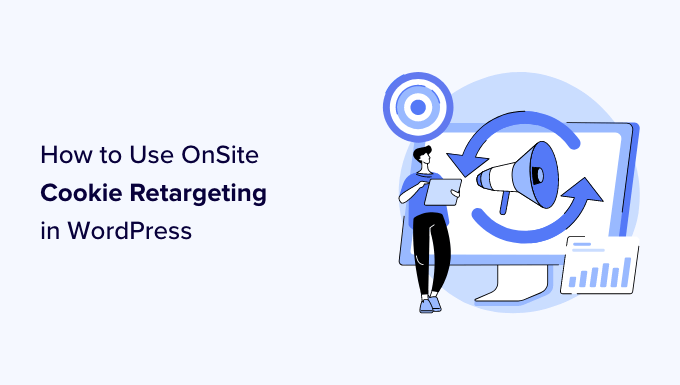
What Is Cookie Retargeting?
Cookie retargeting is a marketing technique where websites use cookies to track user behavior and offer a personalized experience.
There are two types of cookie retargeting techniques.
First, there is off-site cookie retargeting. This method is used to track user activities across the web.
Facebook pixel and Google remarketing are two of the most popular advertising programs that allow you to use their massive reach and show targeted ads to people who visit your website.
Secondly, you have on-site cookie retargeting, which allows you to show targeted messages to users based on how they interact with your WordPress website.
What are cookies?
Cookies are small text files containing pieces of data. Websites set cookies in users’ browsers to store temporary information such as login status, user preferences, session details, and more.
If you’ve landed a specific product page, only to be retargeted with ads for that exact product while browsing on other websites, you know how powerful cookie retargeting is.
Cookie consent and legal requirements
Before setting up any cookie retargeting strategies, you need to make sure your website complies with privacy regulations like GDPR. These laws require you to get permission from your visitors before tracking their activity with cookies.
We recommend using a cookie consent plugin like WPConsent to handle this requirement properly. Unlike other plugins, WPConsent actually protects user privacy by automatically blocking all tracking scripts and cookies until visitors give consent.
Need help setting up cookie consent? See our tutorial on how to add a cookies popup in WordPress for GDPR/CCPA.
How to Use On-Site Cookie Retargeting to Boost Conversions?
There are a number of ways website owners use on-site retargeting messages to boost conversions and increase sales.
Cookies are mainly used to track users’ behavior and then serve targeted content based on their past interactions.
For instance, eCommerce stores can show custom offers to users based on how they interact with other offers. This allows you to create a dynamic sales funnel that leads users to make a purchase.
Another use-case scenario would be lead generation. With on-site retargeting, if a user closes one sign-up form, then you can show them a different message with another offer.
On-site retargeting messages are highly effective because:
💬 It shows personalized messages to users at a time when they are already engaged with your website.
🧑💻 Allows you to create customized campaigns that get better with each user interaction until they convert.
💰 You save money on paid advertising campaigns by utilizing your existing website traffic to the max.
🌐 You can extend the reach of your retargeting by using ads on other platforms.
The idea is to keep your brand top-of-mind and gently nudge your audience down the funnel. For example, when website visitors leave without converting, you could offer them a limited-time discount to help sweeten the deal and remind them what they’re missing out on.
That being said, let’s take a look at how to use cookie retargeting in WordPress. Here’s a quick overview of all the steps we’ll share in this article:
Step 1: Creating On-Site Retargeting Campaign in WordPress
The best way to create on-site retargeting messages is by using OptinMonster. It is the best conversion optimization and lead generation software in the world.
You can use it to easily create attention-grabbing signup forms, popups, welcome mats, in-line offers, custom offers, and more.
✋ Wonder what we use on our site to create promotional pop-ups and slide-ins? We use OptinMonster! See our complete OptinMonster review for details on what it can do.
First, you need to sign up for an OptinMonster account by visiting the website and clicking the ‘Get OptinMonster Now’ button. You’ll need at least their Pro plan for cookie retargeting and Growth plan for follow-up campaigns.
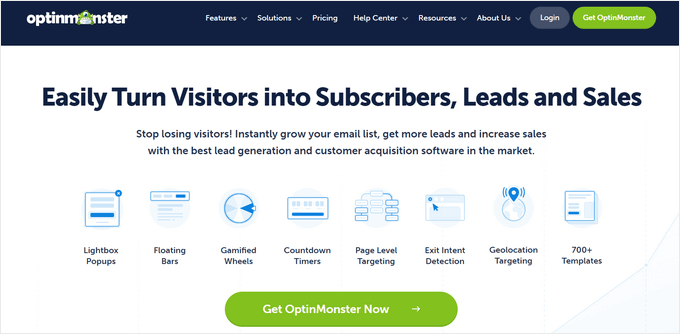
Next, you’ll need to install and activate the OptinMonster plugin. For more details, see our step-by-step guide on how to install a WordPress plugin.
This plugin acts as a connector between your WordPress site and the OptinMonster app.
Upon activation, you will see the welcome screen. Simply click the ‘Connect Your Existing Account’ button.
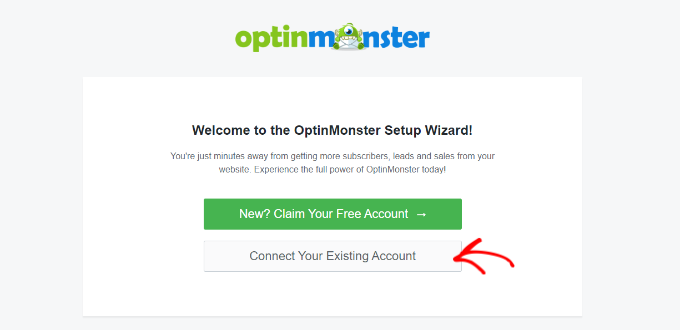
Next, a new window will open, where you’ll need to sign in to your account and connect your website with OptinMonster.
Go ahead and click the ‘Connect to WordPress’ button.
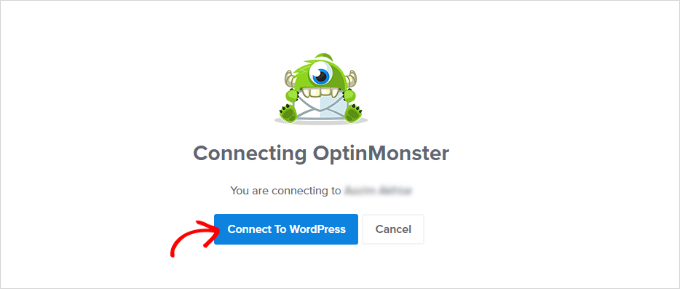
Now, you’re ready to create a new campaign.
First, you’ll need to go to OptinMonster » Campaigns from your WordPress admin panel and then click the ‘Create Your First Campaign’ button.

This will take you to the OptinMonster website, where you’ll be asked to choose a campaign type and a template.
You can choose any campaign type or template, but for this tutorial, we’ll be creating a lightbox popup.
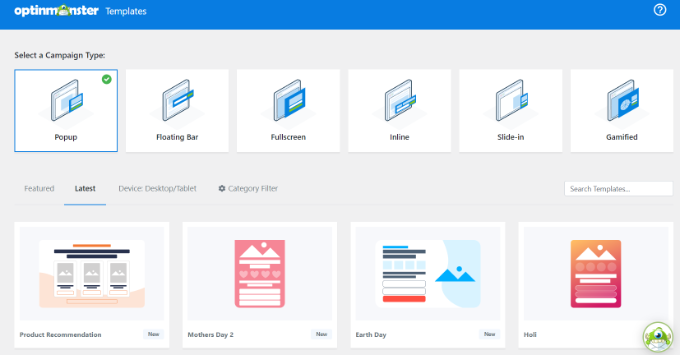
You can select any template that you’d like to use for your campaign.
Next, you’ll be asked to provide a name for your campaign and click the ‘Start Building’ button.

After that, you’ll enter the drag-and-drop campaign builder interface.
It is a powerful design tool where you can simply point and click on any item to edit it. You can also add new items like buttons, images, columns, and more to your popup campaign.
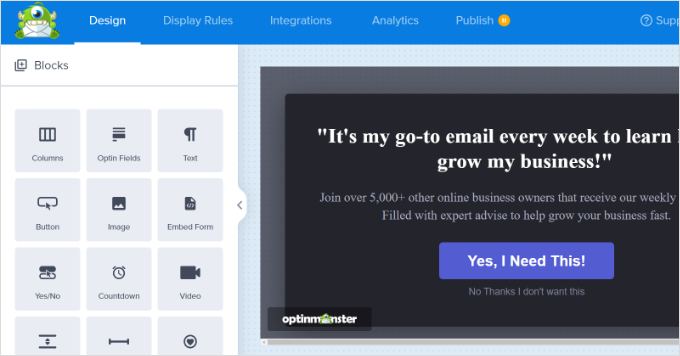
Next, you can switch to the ‘Display Rules’ tab at the top.
Here, OptinMonster will give you different options for displaying your onsite targeting campaigns.
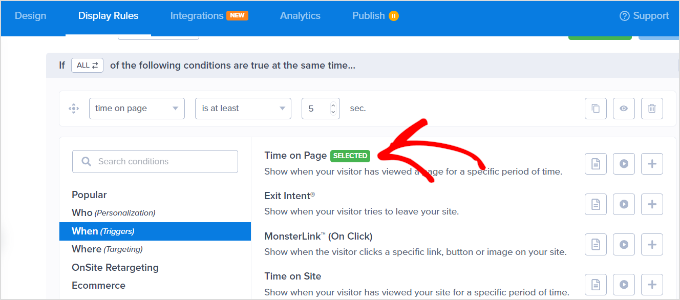
For instance, you can show the popup after users spend a certain amount of time on the page, are from a particular location, or are about to exit your website.
By default, OptinMonster will show your campaign after a visitor spends at least 5 seconds on the site. Plus, it appears on all the pages.
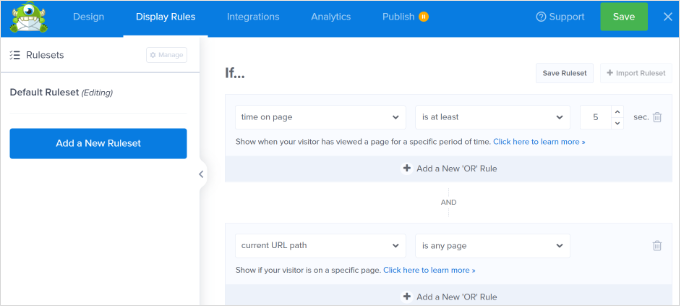
Once you are satisfied, simply switch to the Publish tab.
Next, you’ll need to make your campaign live by changing its status from Draft to Publish. Don’t forget to click the ‘Save’ button when you’re done.
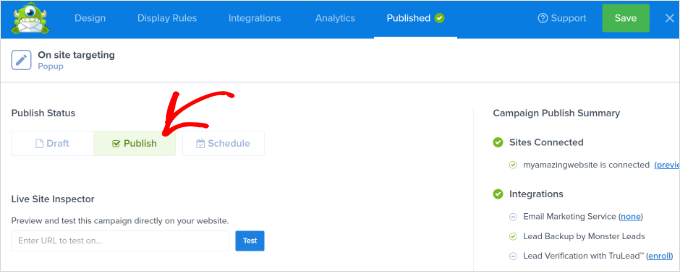
Now by default, OptinMonster will show this campaign to all users who visit your website. Users will be able to close the popup or perform their desired action.
Step 2: Creating a Retargeting Campaign to Show Custom Messages
Now that you have launched your first campaign, let’s add another campaign using the follow-up retargeting feature.
Click on the Create New Campaign button in the OptinMonster dashboard and select your campaign type and template. Since we have used a lightbox popup, we’ll be using a ‘Floating bar’ as our retargeting campaign.
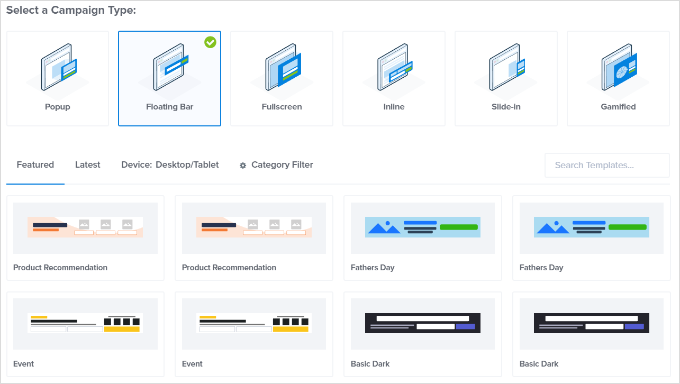
After selecting a template, you’ll enter your campaign name.
Then, simply click the ‘Start Building’ button to continue.

After that, you’ll enter the OptinMonster builder, where you can design your campaign using simple drag-and-drop tools.
You can edit the optin text, adjust the countdown timer to generate FOMO, add a coupon, and so much more.
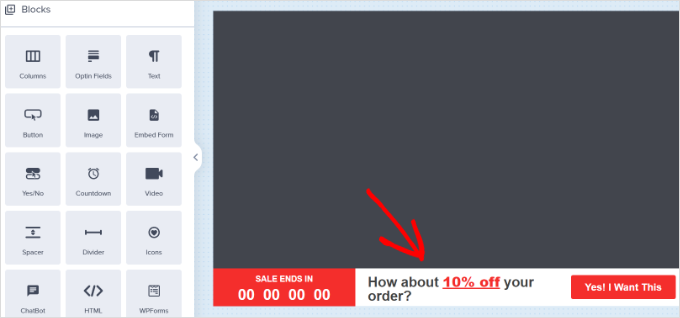
Once you are satisfied with the design, it is time to select which users you want to show this custom message to.
Simply switch to the Display Rules tab at the top of the builder. OptinMonster offers a ton of display rules from which you can choose. You can also add multiple rulesets.
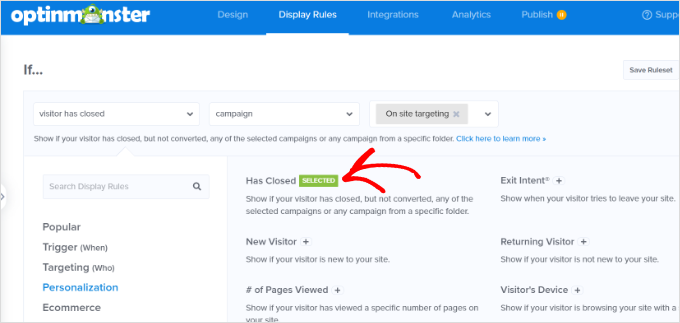
Next, under the If menu, go to the ‘Personalization’ display rules options and select Has Closed.
After that, select ‘Campaign’ and then select your previous campaign.
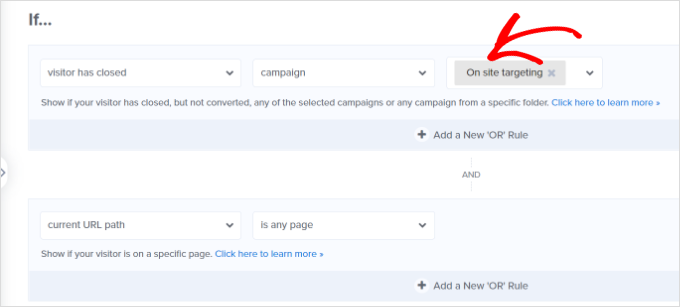
Next, you need to switch to the ‘Publish’ tab.
Here, simply change your campaign status from Draft to Publish under ‘Publish Status.’ Once that’s done, simply click the ‘Save’ button and exit the campaign builder.
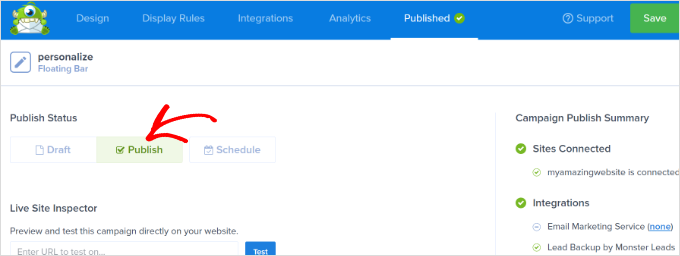
You can now visit your website in the incognito browser tab to see your campaign and the follow-up retargeting message.
Step 3: Adding Cookie Retargeting with Custom Messages
Cookie retargeting allows you to show custom messages to users based on their previous actions, cart status, shopping history, and more.
This allows you to create promotions and upsells designed for customers at different stages of your sales funnel.
When customizing your campaign, simply switch to the ‘Display Rules’ tab.
Under the If menu, you can go to the ‘Targeting (Who)’ display rules options and select Cookie Targeting.
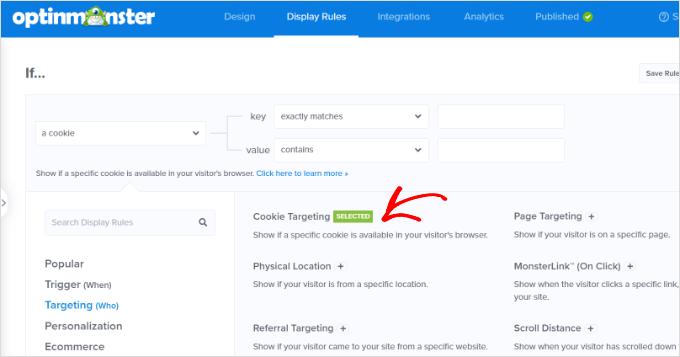
Next, you’ll need to enter the cookie key and value. The key is the cookie name, and the value parameter is the contents of the cookie.
OptinMonster lets you select different operators to use for the display rule. These include options like match exactly, contain, exist, start with, ends with, and more operators.
For instance, if you are using WooCommerce, then you can use WooCommerce cookies to target users who have added products to their cart.
This way, you can cross-sell items in their cart, reduce cart abandonment, and more.
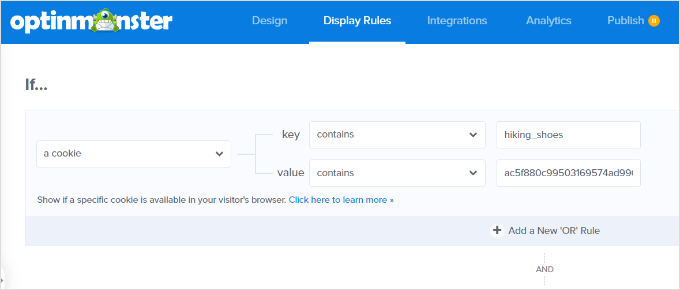
After adding cookie retargeting rules, go to the ‘Publish’ tab.
From here, simply change the Publish Status from Draft to Publish for your campaign.
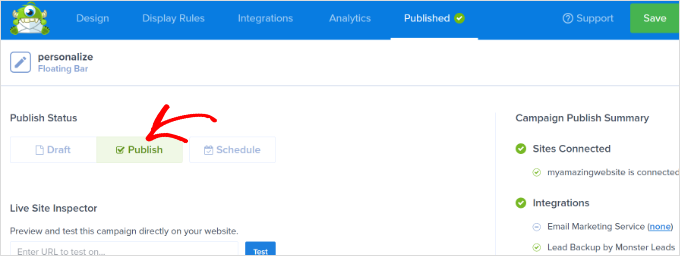
OptinMonster will now display your custom message based on the cookie-targeting rules you have set.
Bonus Step: Optimizing Your Retargeting Campaigns with A/B Tests
Don’t make the mistake of just letting your retargeting campaigns run on auto-pilot without checking how they’re performing.
Like any marketing campaign, you need to always run A/B split tests so that you know which ones are most effective.
You should be tweaking the headlines, copy, offer, or even the target segmentation in your campaigns to boost conversion rates. The good news is that OptinMonster makes setting up various versions of your retargeting messages super easy.
All you need to do is hit the ‘Create Split Test’ icon located in your account dashboard.

A pop-up window will appear. Include any notes so you know which elements of the campaign are being tested.
Click the ‘Create Split Test’ button.
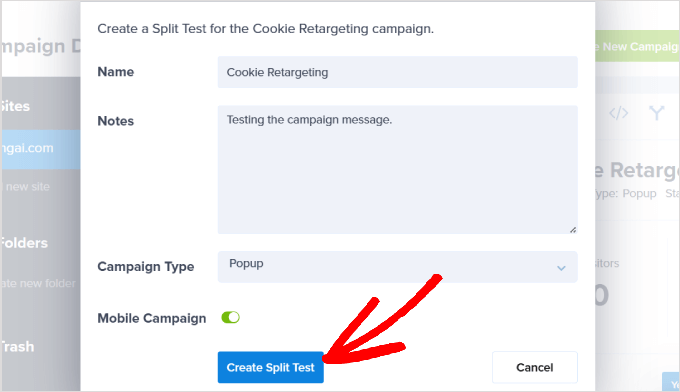
This automatically duplicates your campaign along with the cookie retargeting rules that you’ve set forth. That way, you can make the small tweaks needed to analyze your test.
Then, when published, each version of that campaign randomly appears in your website’s traffic to inform you which is performing better.
Over time, you’ll know what your visitors respond best to, thereby boosting your conversion rates by coming A/B testing with your cookie retargeting campaigns.
We hope this article helped you learn how to use cookie retargeting in WordPress to show custom on-site messages. You may also want to see our ultimate guide to WordPress geolocation targeting as well as our tips for how to grow pricing page conversions by 30%.
If you liked this article, then please subscribe to our YouTube Channel for WordPress video tutorials. You can also find us on Twitter and Facebook.





Have a question or suggestion? Please leave a comment to start the discussion.